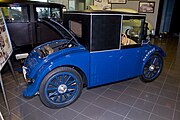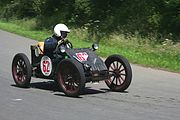
The Honda CR-X, originally launched as the Honda Ballade Sports CR-X in Japan, is a front-wheel-drive sport compact car manufactured by Honda from 1983 until 1991 with nearly 400,000 produced during this period. The first-generation CRX was marketed in some regions outside Japan as the Honda Civic CRX. Although there are many supposed definitions for the initialism CR-X, the most widely accepted is "Civic Renaissance Experimental".

The Peugeot 205 is a supermini (B-segment) car produced by the French manufacturer Peugeot from 1983 to 1999.
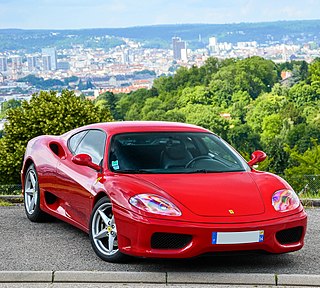
The Ferrari 360 is a two-seater, mid-engine, rear wheel drive sports car manufactured by Italian automotive manufacturer Ferrari from 1999 until 2005. It succeeded the Ferrari F355 and was replaced by the Ferrari F430 in 2004.

The Mercedes-Benz W201 is the internal designation for the Mercedes 190 series sedans, a range of front-engine, rear drive, five passenger, four-door sedans manufactured over a single generation, from 1982 to 1993 as the company's first compact class automobile.

The Porsche 964 is a model of the Porsche 911 sports car manufactured and sold between 1989 and 1994. Designed by Benjamin Dimson through January 1986, it featured significant styling revisions over previous 911 models, most prominently the more integrated bumpers. It was the first car to be offered with Porsche's Tiptronic automatic transmission and all wheel drive as options.

The Volkswagen XL1 is a two-person limited production diesel-powered plug-in hybrid produced by Volkswagen. The XL1 car was designed to be able to travel 100 km on 1 litre of diesel, with a fully charged battery, while being both roadworthy and practical. Without using electric, the XL is able to travel 100 km on 2 litres of diesel. To achieve such economy, it was produced with lightweight materials, a streamlined body and an engine and transmission designed and tuned for economy. The concept car was modified first in 2009 as the L1 and again in 2011 as the XL1.
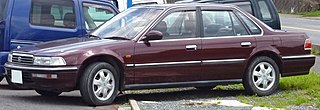
The Honda Ascot is a compact sedan manufactured by Honda and marketed only in Japan from 1989 until 1997. The first generation produced two versions based on the Honda Accord CB series called the Ascot and from 1993 to 1996 a "pillared hardtop" called the Ascot Innova. The Innova shared much of its mechanicals with the European-market Accord manufactured at the Honda UK facility in Swindon, England, and was essentially the badge engineered Rover 600. The second generation was a platform improvement, shared with the Japan-only sedan called the Honda Rafaga. The "Ascot" name was chosen with reference to the Ascot Racecourse and Ascot tie, in order to add the model an alleged air of class and elegance. Honda Ascot was also used on a range of one-cylinder motorcycles in the first half of the 1980s.

The Škoda Fabia is a series of passenger cars produced by Czech manufacturer Škoda Auto since 1999. It is the successor of the Škoda Felicia, which was discontinued in 2001. The Fabia was available in hatchback, estate and saloon body styles at launch, and from 2007, the second generation was offered in hatchback and estate versions. The third generation Fabia was launched in 2015, and the fourth in 2021.

The Toyota KR engine family is a straight-3 piston engine, designed by Daihatsu, a subsidiary of Toyota. The 1KR series uses aluminium engine blocks and chain driven DOHC cylinder heads. It uses multi-point fuel injection, and has 4 valves per cylinder. Some versions have VVT-i variable valve timing. The engine is exceptionally light: 69 kg (152 lb) with all ancillaries. This is due to the nature of the applications and weight of city cars.

The Chevrolet Opala is a Brazilian mid-size car sold under the Chevrolet brand in South America from 1969 to 1992, by General Motors do Brasil. It was derived from the German Opel Rekord Series C, Opel Commodore Series A, but used local design styling and engines derived from North American designs. GM manufactured about one million units including the Opala sedan, Opala Coupé, and the station wagon variant, the Opala Caravan. It was replaced by the Chevrolet Omega in 1992, also an Opel spinoff. It was the first passenger car built by GM in Brazil by the General Motors do Brasil division. A luxury version of the Opala was marketed as the Chevrolet Diplomata.

The Chevrolet Corvette (C6) is the sixth generation of the Corvette sports car that was produced by Chevrolet division of General Motors for the 2005 to 2013 model years. It is the first Corvette with exposed headlamps since the 1962 model. Production variants include the Z06, ZR1, Grand Sport, and 427 Convertible. Racing variants include the C6.R, an American Le Mans Series GT1 championship and 24 Hours of Le Mans GTE-Pro winner.
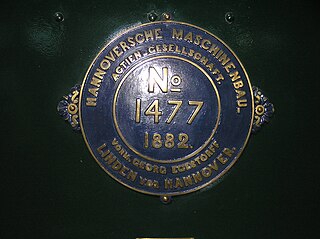
Hanomag was a German producer of steam locomotives, tractors, trucks and military vehicles in Hanover. Hanomag first achieved international fame by delivering numerous steam locomotives to Finland, Romania and Bulgaria before World War I and making of first tractor Hanomag R26 in 1924 in Germany. In 1925, they added automobiles to their line, additionally moving in 1931 into the production of construction machinery. Since 1989, the company has been part of the Komatsu company.

Ponton or pontoon styling is an automotive design genre that spanned roughly from the 1930s-1960s, when pontoon-like bodywork enclosed the full width and uninterrupted length of a car body — eliminating previously distinct running boards and articulated fenders. The integrated fenders of an automobile with ponton styling may also be called Pontoon fenders, and the overall trend may also be known as envelope styling.

The Volkswagen Polo Mk4 is the fourth generation of the Volkswagen Polo supermini car produced by the German manufacturer Volkswagen. It was marketed from early 2002 to 2010 in most countries except Argentina and the USA. It was manufactured in South Africa until 2017, it was sold as the Polo Vivo. The Mk4 replaced the Volkswagen Polo Mk3, while the Polo Vivo replaced the Citi Golf. In 2018 the Mk4 was replaced by the Volkswagen Polo Mk5 Polo Vivo. In Brazil, It was manufactured until 2014 with a second facelift called 9n4, It was replaced in 2017 by Volkswagen Polo Mk6.

The fifth-generation Honda Civic is an automobile produced by Honda from 1991 until 1995. It debuted in Japan on September 9, 1991. At its introduction, it won the Car of the Year Japan award for the second time. Fifth-generation Civics were larger than their predecessors, had more aerodynamic bodies, and the wheelbase was increased to 257 cm (101.3 inches)—for the three-door hatchback—and to 262 cm (103.2 inches)—for the four-door sedan. The Civic Shuttle station wagon was not part of the fifth generation and was dropped for overseas markets, while the previous-generation wagon continued in Japan and Europe.

Diesel engines began to be used in automobiles in the 1930s. Mainly used for commercial applications early on, they did not gain popularity for passenger travel until their development in Europe in the 1950s. After reaching a peak in popularity worldwide around 2015, in the aftermath of Dieselgate, the diesel car rapidly fell out of favor with consumers and regulators.
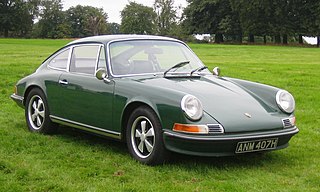
The original Porsche 911 is a luxury sports car made by Porsche AG of Stuttgart, Germany. A prototype of the famous, distinctive, and durable design was shown to the public in autumn 1963. Production began in September 1964 and continued through 1989. It was succeeded by a modified version, internally referred to as Porsche 964 but still sold as Porsche 911, as are current models.

Kommissbrot, formerly Kommißbrot, is a dark type of German bread, baked from rye and other flours, historically used for military provisions.
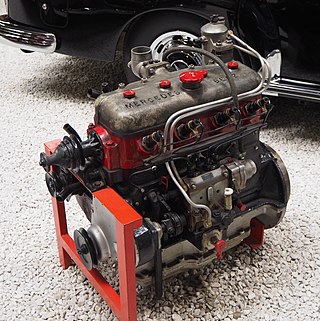
The Mercedes-Benz OM 138 is a diesel engine manufactured by Daimler-Benz. In total, 5,719 units were produced between 1935 and 1940. It was the first diesel engine especially developed and made for a passenger car. The first vehicle powered by the OM 138 was the Mercedes-Benz W 138. The light Mercedes-Benz trucks L 1100 and L 1500 as well as the bus O 1500 were also offered with the OM 138 as an alternative to the standard Otto engine.

The Hanomag Rekord is a mid-size car produced by Hanomag in Hannover from 1933 until 1940. The car was Hanomag's first mid-size model and one of the first mass-produced cars available with a diesel engine. Hanomag introduced the Rekord as the 6/32 PS intermediate model in autumn of 1933; the first car to bear the Rekord name followed shortly thereafter in February 1934. Compared with the 6/32 PS, the Rekords have a longer wheelbase, independent front suspension and different engine ancillaries. In 1937, the vehicle was updated with a new "streamlined" back, and the production of the diesel engine model commenced – prior to 1937, all Rekords were fitted with an Otto engine. In total, Hanomag built 19,104 Rekords.



